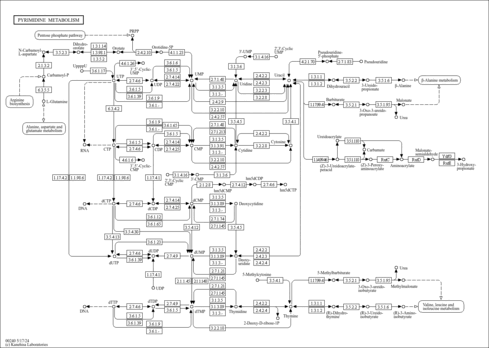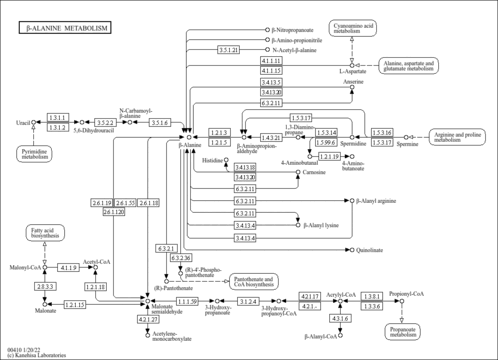| Record Information |
|---|
| Version | 1.0 |
|---|
| Created at | 2020-04-17 18:37:39 UTC |
|---|
| Updated at | 2020-12-07 19:10:57 UTC |
|---|
| CannabisDB ID | CDB004796 |
|---|
| Secondary Accession Numbers | Not Available |
|---|
| Cannabis Compound Identification |
|---|
| Common Name | Dihydrouracil |
|---|
| Description | Dihydrouracil belongs to the class of organic compounds known as pyrimidones. Pyrimidones are compounds that contain a pyrimidine ring, which bears a ketone. Pyrimidine is a 6-membered ring consisting of four carbon atoms and two nitrogen centers at the 1- and 3- ring positions. Dihydrouracil is an extremely weak basic (essentially neutral) compound (based on its pKa). Dihydrouracil exists in all living organisms, ranging from bacteria to humans. Within humans, dihydrouracil participates in a number of enzymatic reactions. In particular, dihydrouracil can be biosynthesized from uracil; which is mediated by the enzyme dihydropyrimidine dehydrogenase [nadp(+)]. In addition, dihydrouracil can be converted into ureidopropionic acid; which is mediated by the enzyme dihydropyrimidinase. In humans, dihydrouracil is involved in the metabolic disorder called the beta-ureidopropionase deficiency pathway. Outside of the human body, Dihydrouracil has been detected, but not quantified in, several different foods, such as arctic blackberries, garden tomato (var.), sweet potato, star fruits, and adzuki beans. This could make dihydrouracil a potential biomarker for the consumption of these foods. Dihydrouracil is a potentially toxic compound. Dihydrouracil, with regard to humans, has been found to be associated with several diseases such as cerebral infarction, liver disease, colorectal cancer, and hypertension; dihydrouracil has also been linked to the inborn metabolic disorder dihydropyrimidine dehydrogenase deficiency. A pyrimidine obtained by formal addition of hydrogen across the 5,6-position of uracil. Dihydrouracil is expected to be in Cannabis as all living plants are known to produce and metabolize it. |
|---|
| Structure | |
|---|
| Synonyms | | Value | Source |
|---|
| 2,4-Dioxotetrahydropyrimidine | ChEBI | | 5,6-Dihydro-2,4-dihydroxypyrimidine | ChEBI | | Dihydro-2,4(1H,3H)-pyrimidinedione | ChEBI | | DIHYDROPYRIMIDINE-2,4(1H,3H)-dione | ChEBI | | Dihydrouracile | ChEBI | | Hydrouracil | ChEBI | | 5,6-Dihydro-2,4(1H,3H)-pyrimidinedione | HMDB | | 5,6-Dihydrouracil | HMDB | | Dihydro-pyrimidine-2,4-dione | HMDB |
|
|---|
| Chemical Formula | C4H6N2O2 |
|---|
| Average Molecular Weight | 114.1 |
|---|
| Monoisotopic Molecular Weight | 114.0429 |
|---|
| IUPAC Name | 1,3-diazinane-2,4-dione |
|---|
| Traditional Name | dihydrouracil |
|---|
| CAS Registry Number | 504-07-4 |
|---|
| SMILES | O=C1CCNC(=O)N1 |
|---|
| InChI Identifier | InChI=1S/C4H6N2O2/c7-3-1-2-5-4(8)6-3/h1-2H2,(H2,5,6,7,8) |
|---|
| InChI Key | OIVLITBTBDPEFK-UHFFFAOYSA-N |
|---|
| Chemical Taxonomy |
|---|
| Description | Belongs to the class of organic compounds known as pyrimidones. Pyrimidones are compounds that contain a pyrimidine ring, which bears a ketone. Pyrimidine is a 6-membered ring consisting of four carbon atoms and two nitrogen centers at the 1- and 3- ring positions. |
|---|
| Kingdom | Organic compounds |
|---|
| Super Class | Organoheterocyclic compounds |
|---|
| Class | Diazines |
|---|
| Sub Class | Pyrimidines and pyrimidine derivatives |
|---|
| Direct Parent | Pyrimidones |
|---|
| Alternative Parents | |
|---|
| Substituents | - N-acyl urea
- Pyrimidone
- Ureide
- 1,3-diazinane
- Dicarboximide
- Urea
- Carbonic acid derivative
- Azacycle
- Carboxylic acid derivative
- Organic oxide
- Organopnictogen compound
- Organooxygen compound
- Organonitrogen compound
- Organic oxygen compound
- Organic nitrogen compound
- Carbonyl group
- Hydrocarbon derivative
- Aliphatic heteromonocyclic compound
|
|---|
| Molecular Framework | Aliphatic heteromonocyclic compounds |
|---|
| External Descriptors | |
|---|
| Ontology |
|---|
|
| Physiological effect | Health effect: |
|---|
| Disposition | Route of exposure: Source: Biological location: |
|---|
| Role | Biological role: Industrial application: |
|---|
| Physical Properties |
|---|
| State | Solid |
|---|
| Experimental Properties | | Property | Value | Reference |
|---|
| Melting Point | 279 - 281 °C | Not Available | | Boiling Point | Not Available | Not Available | | Water Solubility | Not Available | Not Available | | logP | Not Available | Not Available |
|
|---|
| Predicted Properties | [] |
|---|
| Spectra |
|---|
| EI-MS/GC-MS | | Type | Description | Splash Key | View |
|---|
| EI-MS | Mass Spectrum (Electron Ionization) | splash10-03fu-9400000000-5b9edda3479e7d0a0d28 | 2014-09-20 | View Spectrum | | GC-MS | Dihydrouracil, 2 TMS, GC-MS Spectrum | splash10-00di-9700000000-4adeeb2f4f5a1111afb7 | Spectrum | | GC-MS | Dihydrouracil, 1 TMS, GC-MS Spectrum | splash10-00di-5900000000-8af1b81502646fa5b417 | Spectrum | | GC-MS | Dihydrouracil, 2 TMS, GC-MS Spectrum | splash10-0fdo-9750000000-d2aaeeba1cf962175f84 | Spectrum | | GC-MS | Dihydrouracil, non-derivatized, GC-MS Spectrum | splash10-00di-9700000000-4adeeb2f4f5a1111afb7 | Spectrum | | GC-MS | Dihydrouracil, non-derivatized, GC-MS Spectrum | splash10-00di-5900000000-8af1b81502646fa5b417 | Spectrum | | GC-MS | Dihydrouracil, non-derivatized, GC-MS Spectrum | splash10-0fdo-9750000000-d2aaeeba1cf962175f84 | Spectrum | | GC-MS | Dihydrouracil, non-derivatized, GC-MS Spectrum | splash10-0f6w-2940000000-3430a0e2d1819021af1d | Spectrum | | GC-MS | Dihydrouracil, non-derivatized, GC-MS Spectrum | splash10-00di-3900000000-79f2d90a419b7469cb61 | Spectrum | | Predicted GC-MS | Dihydrouracil, non-derivatized, Predicted GC-MS Spectrum - 70eV, Positive | splash10-004l-9100000000-55536f0571922b6c69fe | Spectrum | | Predicted GC-MS | Dihydrouracil, non-derivatized, Predicted GC-MS Spectrum - 70eV, Positive | Not Available | Spectrum |
|
|---|
| MS/MS | | Type | Description | Splash Key | View |
|---|
| MS/MS | LC-MS/MS Spectrum - Quattro_QQQ 10V, Positive (Annotated) | splash10-03k9-9800000000-da772cea603c785c1df4 | 2012-07-24 | View Spectrum | | MS/MS | LC-MS/MS Spectrum - Quattro_QQQ 25V, Positive (Annotated) | splash10-0a4i-9100000000-94a5f543e8c6be7b3204 | 2012-07-24 | View Spectrum | | MS/MS | LC-MS/MS Spectrum - Quattro_QQQ 40V, Positive (Annotated) | splash10-0btc-9200000000-e9bf2ae82714a2a3a737 | 2012-07-24 | View Spectrum | | MS/MS | LC-MS/MS Spectrum - LC-ESI-QTOF (UPLC Q-Tof Premier, Waters) , Positive | splash10-014i-5900000000-0fe83e63f6e5d1347894 | 2012-08-31 | View Spectrum | | MS/MS | LC-MS/MS Spectrum - , negative | splash10-03xr-6900000000-08aca1bc7f27b0e7cb08 | 2017-09-14 | View Spectrum | | MS/MS | LC-MS/MS Spectrum - LC-ESI-QTOF , positive | splash10-014i-5900000000-53ea361c86b4f9fa284b | 2017-09-14 | View Spectrum | | MS/MS | LC-MS/MS Spectrum - , positive | splash10-00di-9300000000-a8599c09cd21e2f84329 | 2017-09-14 | View Spectrum | | MS/MS | LC-MS/MS Spectrum - 10V, Positive | splash10-01b9-9500000000-03c8b6a5b2dc3625d5d3 | 2021-09-20 | View Spectrum | | MS/MS | LC-MS/MS Spectrum - 20V, Positive | splash10-0ab9-9000000000-331f648f78f506788b99 | 2021-09-20 | View Spectrum | | MS/MS | LC-MS/MS Spectrum - 40V, Positive | splash10-052f-9000000000-824aa91d3f2de539f0bd | 2021-09-20 | View Spectrum | | Predicted MS/MS | Predicted LC-MS/MS Spectrum - 10V, Positive | splash10-014i-2900000000-ad7f91d5265e53403dd6 | 2015-05-27 | View Spectrum | | Predicted MS/MS | Predicted LC-MS/MS Spectrum - 20V, Positive | splash10-0603-9200000000-4b30a83fb454e5bbffb8 | 2015-05-27 | View Spectrum | | Predicted MS/MS | Predicted LC-MS/MS Spectrum - 40V, Positive | splash10-0006-9000000000-ce54e3c860a95b0af401 | 2015-05-27 | View Spectrum | | Predicted MS/MS | Predicted LC-MS/MS Spectrum - 10V, Negative | splash10-03di-9800000000-d705e188f6700a76ef72 | 2015-05-27 | View Spectrum | | Predicted MS/MS | Predicted LC-MS/MS Spectrum - 20V, Negative | splash10-0006-9000000000-a26409d69a4259731004 | 2015-05-27 | View Spectrum | | Predicted MS/MS | Predicted LC-MS/MS Spectrum - 40V, Negative | splash10-0006-9000000000-f00c4df547660023bee4 | 2015-05-27 | View Spectrum | | Predicted MS/MS | Predicted LC-MS/MS Spectrum - 10V, Positive | splash10-014i-0900000000-b8f2cf36966bbbbb3285 | 2021-09-23 | View Spectrum | | Predicted MS/MS | Predicted LC-MS/MS Spectrum - 20V, Positive | splash10-014i-9500000000-44775319047d2eddad49 | 2021-09-23 | View Spectrum | | Predicted MS/MS | Predicted LC-MS/MS Spectrum - 40V, Positive | splash10-052f-9000000000-3cb7005ca8389854848e | 2021-09-23 | View Spectrum | | Predicted MS/MS | Predicted LC-MS/MS Spectrum - 10V, Negative | splash10-03dl-7900000000-9d78d5698ad7865d1789 | 2021-09-25 | View Spectrum | | Predicted MS/MS | Predicted LC-MS/MS Spectrum - 20V, Negative | splash10-0006-9000000000-997cffdd9ad85c899225 | 2021-09-25 | View Spectrum | | Predicted MS/MS | Predicted LC-MS/MS Spectrum - 40V, Negative | splash10-0006-9000000000-a88e812ae86e53f6c2d6 | 2021-09-25 | View Spectrum |
|
|---|
| NMR | | Type | Description | | View |
|---|
| 1D NMR | 1H NMR Spectrum (1D, 500 MHz, H2O, experimental) | | Spectrum | | 1D NMR | 1H NMR Spectrum (1D, 400 MHz, DMSO-d6, experimental) | | Spectrum | | 1D NMR | 13C NMR Spectrum (1D, 15.08 MHz, DMSO-d6, experimental) | | Spectrum | | 1D NMR | 1H NMR Spectrum (1D, 100 MHz, D2O, predicted) | | Spectrum | | 1D NMR | 13C NMR Spectrum (1D, 100 MHz, D2O, predicted) | | Spectrum | | 1D NMR | 1H NMR Spectrum (1D, 200 MHz, D2O, predicted) | | Spectrum | | 1D NMR | 13C NMR Spectrum (1D, 200 MHz, D2O, predicted) | | Spectrum | | 1D NMR | 1H NMR Spectrum (1D, 300 MHz, D2O, predicted) | | Spectrum | | 1D NMR | 13C NMR Spectrum (1D, 300 MHz, D2O, predicted) | | Spectrum | | 1D NMR | 1H NMR Spectrum (1D, 400 MHz, D2O, predicted) | | Spectrum | | 1D NMR | 13C NMR Spectrum (1D, 400 MHz, D2O, predicted) | | Spectrum | | 1D NMR | 1H NMR Spectrum (1D, 500 MHz, D2O, predicted) | | Spectrum | | 1D NMR | 13C NMR Spectrum (1D, 500 MHz, D2O, predicted) | | Spectrum | | 1D NMR | 1H NMR Spectrum (1D, 600 MHz, D2O, predicted) | | Spectrum | | 1D NMR | 13C NMR Spectrum (1D, 600 MHz, D2O, predicted) | | Spectrum | | 1D NMR | 1H NMR Spectrum (1D, 700 MHz, D2O, predicted) | | Spectrum | | 1D NMR | 13C NMR Spectrum (1D, 700 MHz, D2O, predicted) | | Spectrum | | 1D NMR | 1H NMR Spectrum (1D, 800 MHz, D2O, predicted) | | Spectrum | | 1D NMR | 13C NMR Spectrum (1D, 800 MHz, D2O, predicted) | | Spectrum | | 1D NMR | 1H NMR Spectrum (1D, 900 MHz, D2O, predicted) | | Spectrum | | 1D NMR | 13C NMR Spectrum (1D, 900 MHz, D2O, predicted) | | Spectrum | | 1D NMR | 1H NMR Spectrum (1D, 1000 MHz, D2O, predicted) | | Spectrum | | 1D NMR | 13C NMR Spectrum (1D, 1000 MHz, D2O, predicted) | | Spectrum | | 2D NMR | [1H, 13C]-HSQC NMR Spectrum (2D, 600 MHz, H2O, experimental) | | Spectrum |
|
|---|
| Pathways |
|---|
| Pathways | | Name | SMPDB/Pathwhiz | KEGG | | Pyrimidine Metabolism |    |  | | Beta-Alanine Metabolism |    |  | | GABA-Transaminase Deficiency |    | Not Available | | Ureidopropionase Deficiency |    | Not Available | | Carnosinuria, carnosinemia |    | Not Available |
|
|---|
| Protein Targets |
|---|
| Enzymes | |
|---|
| Transporters | Not Available |
|---|
| Metal Bindings | |
|---|
| Receptors | Not Available |
|---|
| Transcriptional Factors | Not Available |
|---|
| Concentrations Data |
|---|
| Not Available |
|---|
| External Links |
|---|
| HMDB ID | HMDB0000076 |
|---|
| DrugBank ID | DB01849 |
|---|
| Phenol Explorer Compound ID | Not Available |
|---|
| FoodDB ID | FDB030556 |
|---|
| KNApSAcK ID | Not Available |
|---|
| Chemspider ID | 629 |
|---|
| KEGG Compound ID | C00429 |
|---|
| BioCyc ID | DI-H-URACIL |
|---|
| BiGG ID | 34956 |
|---|
| Wikipedia Link | Dihydrouracil |
|---|
| METLIN ID | 285 |
|---|
| PubChem Compound | 649 |
|---|
| PDB ID | Not Available |
|---|
| ChEBI ID | 15901 |
|---|
| References |
|---|
| General References | Not Available |
|---|

